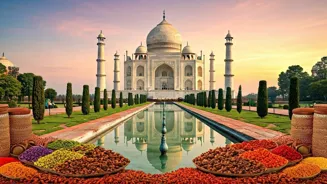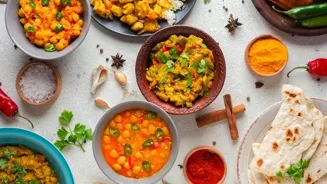Delve into the world of Indian chaat: A sensory journey through the heart of street food delights!
India, a land of vibrant colors, diverse cultures, and a culinary heritage that spans centuries, is also
the undisputed champion of street food. Among the myriad of delectable offerings, chaat reigns supreme.
It’s not just food; it’s an emotion, a sensory explosion that tantalizes taste buds and leaves you craving for more.
From the bustling streets of Delhi to the vibrant lanes of Mumbai, chaat vendors dish out a symphony of flavors, textures, and aromas that define the very essence of Indian street food.
This guide delves into the fascinating world of Indian chaat, exploring its origins, regional variations, and the essential elements that make it so irresistible. So, fasten your seatbelts and prepare for a flavorful journey through the heart of Indian street food!
Chaat's evolution from Mughal era to pan-Indian snack
Chaat, a word derived from the Hindi verb "chaatna," meaning "to lick," perfectly encapsulates the finger-licking goodness of these savory snacks. The origins of chaat are shrouded in mystery, with various theories and legends surrounding its inception.
One popular belief traces its roots back to the Mughal era, when royal chefs experimented with innovative ways to create light and refreshing snacks for the emperor.
Another theory suggests that chaat originated in Uttar Pradesh, particularly in cities like Lucknow and Agra, before spreading its wings across the country.
Regardless of its precise origins, chaat has evolved over time, incorporating influences from different regions and cultures, making it a truly pan-Indian phenomenon. Each region has adopted chaat and adjusted the ingredients that aligns and works with the local produce and tastes.
Indian chaat: diverse regional variations, each with unique flavors and experiences
The beauty of Indian chaat lies in its incredible diversity. Every region boasts its own unique variations, each offering a distinct flavor profile and culinary experience.
In Delhi, the undisputed king of chaat is undoubtedly the aloo tikki, a crispy potato patty served with a generous dollop of chutney, yogurt, and spices.
Golgappe, also known as puchka or pani puri in other parts of India, are another Delhi favorite, consisting of hollow, crispy spheres filled with spiced potatoes, chickpeas, and tangy water.
Moving westward to Mumbai, you'll find sev puri, a medley of crispy puris topped with potatoes, onions, chutneys, and a generous sprinkle of sev (thin, crispy noodles made from gram flour).
Bhel puri, another Mumbai staple, is a delightful mix of puffed rice, vegetables, chutneys, and spices, offering a perfect balance of sweet, sour, and spicy flavors. Each region has its unique interpretation of chaat, showcasing the creativity and culinary genius of local cooks.
Indian chaat: base, toppings, chutneys, spices - a flavorful symphony
No discussion of Indian chaat is complete without mentioning the essential elements that make it so special. Firstly, there's the base, which can range from crispy puris and papdis to aloo tikkis and samosas.
Then comes the array of toppings, including diced potatoes, onions, tomatoes, chickpeas, and sprouts, each adding its own unique texture and flavor. But the real magic lies in the chutneys, the soul of any chaat dish.
Green chutney, made from coriander, mint, and green chilies, adds a refreshing and spicy kick, while tamarind chutney, with its sweet and tangy notes, provides a counterpoint to the other flavors.
Yogurt, often sweetened and spiced, adds a creamy and cooling element, balancing the heat of the spices. Finally, the chaat is garnished with a generous sprinkle of spices, such as chaat masala, cumin powder, and red chili powder, adding the final layer of flavor and aroma.
Chaat making: A culinary art of balancing flavors and tradition
The art of chaat making is a delicate balancing act, requiring skill, precision, and a deep understanding of flavors. A good chaat vendor is not just a cook but an artist, carefully layering the ingredients to create a symphony of taste and texture.
The key is to achieve the perfect balance of sweet, sour, spicy, and savory flavors, ensuring that each bite is a burst of sensory delight. The presentation is also crucial, with colorful toppings and garnishes making the chaat visually appealing and enticing.
Many chaat vendors have perfected their recipes over generations, passing down the secrets of their trade from one generation to the next. It's a tradition that's deeply ingrained in Indian culture, with chaat vendors playing an important role in the social fabric of their communities.
Chaat in India: more than food, a cultural experience
Beyond its deliciousness, chaat also offers a glimpse into the social and cultural life of India. Street food stalls are more than just places to grab a quick bite; they are social hubs where people from all walks of life come together to enjoy a shared culinary experience.
The lively atmosphere, the hustle and bustle of the crowds, and the aroma of spices all contribute to the unique charm of Indian street food. Chatting with the chaat vendor, sharing a laugh with fellow diners, and observing the street life around you are all part of the chaat experience.
It's a reminder that food is not just about sustenance; it's about community, connection, and celebrating the joy of life. So, the next time you find yourself in India, don't hesitate to dive into the world of chaat.
It's an experience that will tantalize your taste buds, enrich your senses, and leave you with memories that will last a lifetime.
AI Generated Content. Glance/InMobi shall have no liability for the content










